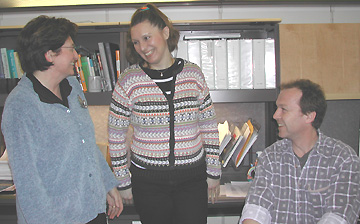
| T H E N I H C A T A L Y S T | M A R C H – A P R I L 2002 |
|
|
|
Bench-to-Bedside: Looking for Genomic Markers of Cancer
NCI
INVESTIGATORS SEEK EARLIER
ALERT TO BREAST CANCER
|
 |
|
Collaborators:
(left to right) Ruthann Giusti, Kerstin Heselmeyer-Haddad, and Thomas
Ried hope to establish the value of breast ductal lavage and ductal cell
fluid analysis for earlier detection of breast cancer and breast cancer
precursors in high-risk women
|
Imaging techniques for the detection of breast cancer have been faulted for a lack of specificity—a shortcoming that is magnified in women genetically at high risk for breast cancer.
Women with a mutation in the BRCA1 and/or BRCA2 genes have a lifetime risk of breast cancer that is estimated to be between 56 and 85 percent. Many of these women will develop breast cancer at a young age when mammography is least likely to be effective because a small cancer can be obscured by the dense breast tissue of young women.
Innovative approaches to screening for early breast cancer in women at high genetic risk are clearly needed.
That is the crux of the Bench-to-Bedside project on "Genomic Changes in Premalignant, Preinvasive, and Invasive Breast Cancer in Women Genetically at High Risk for Breast Cancer," conducted by Ruthann Giusti, staff clinician in the Clinical Genetics Branch, Division of Cancer Epidemiology and Genetics, NCI, and Thomas Ried, a senior investigator in the Genetics Department of NCI.
Approximately 200 women at high genetic risk of breast cancer will be enrolled into a screening study that includes mammography, breast magnetic resonance imaging, positron emission tomography, and breast ductal lavage done annually for four years.
Breast cancer develops from the cells of the breast duct epithelium. Breast ductal lavage (BDL) is a newly developed method of cell collection that introduces a microcatheter into the nipple duct openings and recovers far greater numbers of ductal epithelial cells than is possible by traditional nipple aspiration.
The procedure is minimally invasive, safe, and well tolerated, Giusti says.
Ried and Kerstin Heselmeyer-Haddad, a research fellow in the NCI Genetics Department, are applying fluorescence in situ hybridization (FISH) analysis for specific tumor markers on BDL samples and have designed a probe set to analyze gains in oncogenes such as myc or her and losses in the Tp53 tumor suppressor gene.
FISH allows the analysis of ductal cell fluid for genomic imbalances known to occur in breast cancer—and it is hoped that this study will produce a sensitive, specific, and predictive test for the presence of tumor cells or cells that are committed to malignant transformation.
In a progress report on their project, the investigators note that "It has now been established that the pattern of genomic imbalances is both tumor site and stage specific. In breast cancer and its precursor lesions, the most recurring copy-number alterations map to chromosome 17 and to chromosome arms 1q, 8q, and 20q. The detection of this nonrandom and reproducible pattern of specific DNA gains and losses therefore has potential to complement standard morphological evaluation of cells with genetic markers of tumorigenesis."
"The advantage of this procedure," says Ried, "is that we can combine specific genetic markers with conventional cytopathology studies."
Preliminary studies have demonstrated the accuracy of these probe sets in analyzing cells from nipple aspirates, Heselmeyer-Haddad says, noting that "the FISH procedure can be completed in a matter of hours and with high-throughput automated analysis, one can have the results of a BDL sample the day after cell collection."
Analysis of BDL fluid will not replace the need for mammography, Giusti says, but detection of cancer at its earliest stages may provide patients with more options for clinical management of breast cancer.
Detection of precancerous
changes, she notes "may help high-risk patients weigh the timing of the
use of chemopreventives or prophylactic surgery to lower breast cancer risk
and, we hope, enable us to learn more about the pathogenesis of breast cancer
in this high-risk group." ![]()
| A
parallel BDL project is among the most recent Bench-to-Bedside
awardees: "Characterization of High-Risk Breast Duct Epithelium
by Cytology, Breast Endoscopy, and cDNA Gene Expression Profile" (David
Danforth and Patricia
Steeg, NCI).
|